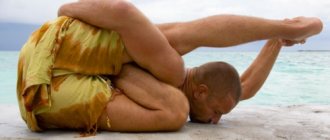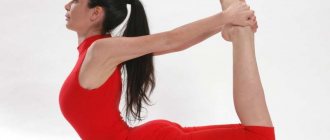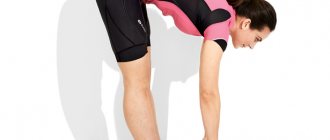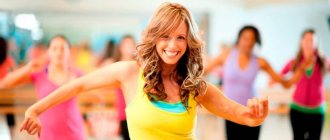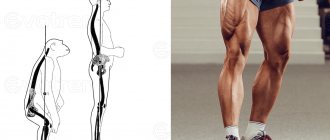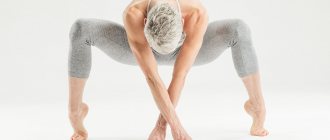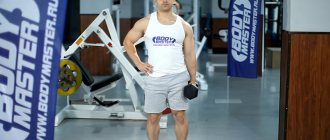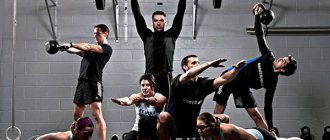Tadasana (or Samasthiti ) is the name of the mountain pose. This is the very first and seemingly simple asana that beginners encounter. In it you need to stand firmly and straight, like a mountain (“Tada” is translated from Sanskrit as mountain, “Sama” is vertical, straight, “Sthiti” is motionless). But it's not easy at all! Let's look at all the nuances, find out the technique, possible contraindications and the great benefits of this exercise.
Standing correctly is an art! Previously, people understood it naturally: they walked barefoot on the ground, distributing their body weight over the entire surface of their feet. That’s why they were strong and “grounded”. Now we wear shoes, and women also wear heels, we live mainly in high-rise buildings, and work in offices. There is concrete and asphalt all over us. Why am I doing all this? Besides, we don’t really walk barefoot on Mother Earth... But she can teach us a lot.
But, as a rule, we don’t care about this. We don't pay attention to how we stand. Some people are used to transferring their body weight only on one leg, others on their heels or the edge of their feet. Just for fun, look at your shoes now! She will explain a lot to you. On which side the sole wears the most, that part of the foot you load. Place your body weight there. And it should be distributed evenly. And that's why.
Look, if the body weight rests, for example, only on the heels, deformation of the spine is inevitable. Alas, this is true. In this position, the hips and pelvis stop working (and they should be involved), become sluggish, and the whole body seems to fall back. At the same time, a person may feel tension in the spine (or already get used to it), walk with a protruding stomach, even without excess weight. Stooping, strange gait... And this is not all misfortune. Fatigue and sadness will begin to overcome him. It would seem that you just woke up - but you no longer have the strength, your mind is sluggish... Do you feel the connection? This is why it is so important to stand correctly.
And this is what mountain pose teaches us in yoga!
show more
Benefits of exercise
Everyone needs Tadasana! Especially for those who sit at the computer a lot, move little, and don’t play sports. Arthritis, slouching, a “hump” in the upper back, poor mobility in the neck and shoulders, as well as numbness in the feet and congestion in the calves and thighs are all direct indications that it’s time for you to practice mountain pose. So, why is it so good:
- teaches you to distribute body weight over the entire surface of the foot;
- improves posture;
- ensures proper growth of vertebral bones (at a young age);
- keeps the spine, as well as the joints of the arms and legs young and flexible;
- promotes the release of spinal nerves;
- strengthens abdominal muscles: both external and internal;
- eliminates constipation;
- lifts tone, restores vigor and energy.
Photo: anna.yoga.dubai, adept.yoga
Tips for doing Tadasana Mountain Pose
Take a free master class for beginners to practice yoga. An experienced teacher will tell you how to use asanas effectively.
Regular training against a wall or in front of a mirror will help a beginner learn to control the correct execution of the exercise and maintain balance.
If you have difficulty keeping your feet together and maintaining balance, leave no more space between your feet than the width of your feet.
When taking a pose, feel whether you can perform it even better, or whether you should listen to your body and internal sensations.
Important! The main conditions for performing yoga exercises are reasonableness and lack of violence against oneself.
Step-by-step execution technique
Step 1
We stand up straight, bringing our feet together so that the heels and big toes touch. Fingers extended.
Step 2
We distribute the body weight evenly over the surface of the feet: on the heels, and on the middle of the foot, and on the toes. It feels like roots are growing and you are becoming “rooted.”
Step 3
Strain your knees, pulling your kneecaps up.
ATTENTION! Legs are straight and tense.
Step 4 Pull your stomach up, move your chest forward and “open” it. We stretch the spine up. Straighten your neck, slightly tilting your chin to your chest.
Step 5 In the classic version of mountain pose, the arms are extended upward above the head. But you can fold them at chest level into a prayer mudra (Namaste), or lower them down the sides of the body.
So, we stretch our arms up from the sides, palms facing each other. We push the floor with our feet and stretch our whole body up, following our arms.
Step 6 Maintain the position for 30-60 seconds, breathing evenly. Upon completion, take a deep breath and relax. And again we enter Tadasana.
Effect
People don't pay attention to proper posture. Some people stand with their body weight on only one leg or with one leg completely out to the side. Some rest only on their heels or on the outer or inner edges of their feet. This can be seen by the wear pattern of the heels and outsoles. Due to the habit of standing incorrectly, without distributing the body weight evenly over the entire foot, we acquire specific deformations that impede the flexibility of the spine. Even if you keep your feet apart, it is better to keep your toes and heels parallel rather than at an angle to each other. In this case, the hips contract, the stomach is pulled inward, and the chest moves forward. This creates a feeling of lightness in the body and the mind becomes alert. If we stand, transferring the entire weight of the body to the heels, we feel how the nature of gravity changes: the hips relax, the stomach protrudes forward, the body leans back, tension is felt in the spine, as a result we soon get tired and the mind becomes sluggish. Therefore, it is very essential to learn how to stand correctly.
General information about Tadasana
Tadasana is considered a complex-forming pose (it is part of many others), and is quite popular, which is not at all surprising. It is probably impossible to find yoga teachers who do not practice Mountain Pose in their classes.
Previously, we talked about the technique of performing kakasana - crow pose.
Benefits of Tadasana
Tadasana has a positive effect on the entire body. It stimulates and trains the limbs, develops correct posture, teaches not to slouch, and eliminates deformities. The spinal column in this position is extended and straightened.
This is incredibly useful in the modern world, when more and more people spend their entire working day at the computer, spend their free time buried in gadgets, move little and have problems with the spine “thanks” to this.
All standing exercises and Tadasana Mountain Pose are also designed to revive in us a sense of calm, staticity, and integrity.
It happens that in ordinary life we simply forget how to stand correctly and maintain posture, and the Mountain Pose will teach us this.
It is known that problems with the spine affect overall health and negatively affect well-being. The practice of mountain pose has a rejuvenating effect on the body, strengthens sleep, and waking up in the morning becomes light and cheerful, and overall tone improves.
If we talk about the more subtle aspects of Tadasana, it activates the important heart chakra, this allows you to become calm, focused and peaceful.
Additional Tips
- For many people, the heels should be slightly offset from each other, but the inner bones are still together.
- To help lengthen and widen your toes, your entire foot, or to make your legs stronger, you can momentarily lift your toes up. Then the toes will lengthen and stretch, the base of the toes will widen, the insides of the feet will increase, elongating the middle of the foot, and the kneecaps will rise even more.
- Stand and distribute the load evenly on each foot. The inner and outer edges, the forefoot and the back of the foot should be equally loaded.
- Press the inside edge of your heel into the ground as hard as possible, where the heel ends and the dome of the sole begins.
- Just as you press evenly on the four corners of your foot, distribute the force to evenly extend your legs on all four sides: inside, outside, front and back. You must be aware of these actions.
- When feeling and improving your legs or other parts of the body, keep your feet in your awareness as well. Make contact with the ground. This stabilizes the mind. Feel how the work done in one place moves to other even very distant places.
- The inner and outer sides of the knees should be equally open, with the inner sides stretching upward.
- Work from your feet to lift your chest bone straight up, widen your collarbones and shoulders while tucking your shoulder blades inside and widening your shoulders. Don't push out the front lower ribs
Beneficial properties of Sukhasana
This asana will help you form beautiful posture.
When performed correctly, it relieves tension in the knee and hip joints, which is useful for people who spend a lot of time on their feet.
The Sukhasana pose is simple to perform, but it brings significant benefits:
- trains the mobility of the knees, ankles and hips;
- increases blood circulation in the abdominal cavity, lower back and pelvis;
- increases stretching of leg muscles;
- its stability promotes peace of mind while maintaining body tone.
Correct execution of basic asanas will help you subsequently master more complex variations without injury. But for meditation practices it alone will be enough.
For beginners
Beginners can stand against a wall to get a feel for how level they are. The shins, sacrum, shoulder blades, back of the shoulders, and back of the head should be in contact with the wall.
Standing asanas such as Mountain Pose, Tree Pose, Chair Pose, Extended Triangle Pose, Warrior 2 Pose are those that are recommended for beginners. They are also done at the beginning of the class because they warm up the body and prepare it for more difficult asanas.
Exit from asana
As you exhale, lower your heels to the floor and place your hands on the top of your head, palms facing your head. This is the exit from the final position and also the end of one cycle.
Relax for a few seconds, keeping your hands on your head, then repeat the pose, while inhaling, stretching your arms and whole body up, turning your palms towards the ceiling, and rising onto your toes.
Practice 5 to 10 cycles. Then, as you exhale, lower yourself onto your heels, lower your arms to the sides of your body (you can also lower your head a little), and relax.
Restrictions
There are no special contraindications for Tadasana, but certain restrictions still exist. Caution is exercised in case of frequent headaches, unstable blood pressure, osteochondrosis and osteoarthritis, and cerebrovascular accidents.
A person spends a lot of time sitting, which is not at all provided for by his nature. As a result, your health deteriorates and your energy suffers.
Standing Mountain Pose restores a sense of confidence and physical and mental balance.
ASHTANGA YOGA STUDIO KMV
Tadasana performed by BKS Iyengar
Tada - mountain, Sama - vertical, straight, motionless, Sthiti - standing quietly, immobility. Thus, Tadasana is a pose in which you need to stand firmly, straight, like a mountain. This is the basic standing pose.
People do not pay attention to correct posture, and it is very important for good health and a properly functioning musculoskeletal system (MSD). Asymmetrical positioning of the legs and incorrect position of the pelvis use the muscles of the body differently and form deformed posture. At some point in time, when it seems to you that you are standing straight, pay attention to the feet, their position (symmetrical or not) will reveal to you the true picture of the state of your musculoskeletal system. Also examine the soles of your shoes; uneven wear will indicate overloaded sides of the feet and bowed feet. Correct distribution of the load across the musculoskeletal system is the key to reasonable energy expenditure by the body, correct position of internal organs and, based on this, good health.
Effect of asana
Imperceptibly, from class to class, the asana straightens the spine, correctly forms the muscles of the thighs and calf muscles, opens the chest, removes stoop and correctly shapes the position of the pelvis. The effectiveness of this asana can be judged by the posture of military personnel who practice its analogue many times during the day in formations, following the command “Attention!”
Execution order
- Stand straight with your feet together. Make sure your big toes are in line. The big toes and heels of the feet touch. Lower the heads of the metatarsal bones (bases of the toes) to the floor, with the toes extended as far as possible along the floor.
- Knees tight, kneecaps tucked, upper thighs tight, hamstrings tight.
- Point the tailbone down and the pubic bone up, thus rotating the pelvis back and removing excess deflection in the lumbar spine. Also, pull your stomach in and push your chest forward. Pull your spine up.
- The body weight is distributed evenly over the area where the feet touch the floor.
- The arms in one version (Iyengar style) are fully extended along the body and moved away from it at an angle of 15-20 degrees. In another version (Ashtanga Vinyasa style), the arms are also fully extended, but pressed to the hips.
- Breathing is slow, calm, abdominal (abdominal type).
Young Pattabhi Jois demonstrating the position of Samasthiti
All standing poses begin with this asana.
Common mistakes
- Feet are asymmetrical on the floor. Toes curled. Toes and heels do not touch each other
- The pelvis is not rotated back, but tilted forward (the pubic bone is not raised up, the stomach is not retracted). From here, excess lordosis remains (deflection of the spine in the lumbar region) and from here, in the thoracic region, excess kyphosis (stooping) remains, as compensation of the spine with lordosis. In this case, the head will most likely also be excessively tilted forward (due to kyphosis), and the chest back.
- The hands are not placed on the side of the thighs, but are moved slightly forward. This mistake is typical for people with “rolled” shoulders forward. Control the position of your hands and if you notice such a tendency, always control your shoulders by turning them back.

